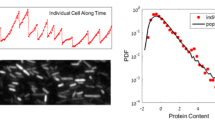Abstract
The fluctuation experiment is an essential tool for measuring microbial mutation rates in the laboratory. When inferring the mutation rate from an experiment, one assumes that the number of mutants in each test tube follows a common distribution. This assumption conceptually restricts the scope of applicability of fluctuation assay. We relax this assumption by proposing a Bayesian two-level model, under which an experiment-wide average mutation rate can be defined. The new model suggests a gamma mixture of the Luria-Delbrück distribution, which coincides with a recently discovered discrete distribution. While the mixture model is of considerable independent interest in fluctuation assay, it also offers a practical Markov chain Monte Carlo method for estimating mutation rates. We illustrate the Bayesian approach with a detailed analysis of an actual fluctuation experiment.





Similar content being viewed by others
References
Albert J (2007) Bayesian computation with R. Wiley, New York
Asteris G, Sarkar S (1996) Bayesian procedures for the estimation of mutation rates from fluctuation experiments. Genetics 142:313–326
Carlin BP, Louis TA (2009) Bayesian methods for data analysis, 3rd edn. CRC Press, Boca Raton
Christiansen CL, Morris CN (1995) Fitting and checking a two-level Poisson model: modeling patient mortality rates in heart transplant patients. In: Berry D, Stangl D (eds) Bayesian biostatistics. Barcel Dekker, New York
Crane GJ, Thomas SM, Jones ME (1996) A modified Luria-Delbrück fluctuation assay for estimating and comparing mutation rates. Mutat Res 354:171–182
Foster PL (2006) Methods for determining spontaneous mutation rates. Methods Enzymol 409:195–213
Gelman A, Carlin JB, Stern HS, Robin DB (2004) Bayesian data analysis, 2nd edn. Chapman & Hall, Boca Raton
Jones ME, Thomas SM, Rogers A (1994) Luria-Delbrück fluctuation experiments: design and analysis. Genetics 136:1209–1216
Kimmel M, Axelrod DE (1994) Fluctuation test for two-stage mutations: application to gene amplification. Mutat Res 306:45–60
Lea EA, Coulson CA (1949) The distribution of the numbers of mutants in bacterial populations. J Genet 49:264–285
Luria SE, Delbrück M (1943) Mutations of bacteria from virus sensitivity to virus resistance. Genetics 28:491–511
Ma WT, Sandri GvH, Sarkar S (1992) Analysis of the Luria-Delbrück distribution using discrete convolution powers. J Appl Probab 29:255–267
Rosche WA, Foster PL (2000) Determining mutation rates in bacterial populations. Methods 20:4–17
Rossman TG, Goncharova EI, Nádas A (1995) Modeling and measurement of the spontaneous mutation rate in mammalian cells. Mutat Res 328:21–30
Stewart FM (1994) Fluctuation tests: how reliable are the estimates of mutation rates? Genetics 137:1139–1146
Wu X, Strome ED, Meng Q, Hastings PJ, Plon SE, Kimmel M (2009) A robust estimator of mutation rates. Mutat Res 661:101–109
Zheng Q (1999) Progress of a half century in the study of the Luria-Delbrück distribution. Math Biosci 162:1–32
Zheng Q (2002) Statistical and algorithmic methods for fluctuation analysis with SALVADOR as an implementation. Math Biosci 176:237–252
Zheng Q (2008) SALVADOR 2.3: A tool for studying mutation rates, Mathematica package available for download at http://library.wolfram.com/infocenter/MathSource/7082. Accessed 7 Jan 2012
Zheng Q (2010) A new discrete distribution induced by the Luria-Delbrück mutation model. Statistics 44:529–540
Acknowledgments
I am most grateful to Professor P. Foster who drew my attention to the problem addressed here and who kindly provided unpublished experimental data. I am also indebted to two conscientious reviewers for many insightful comments that led to a substantially improved manuscript. The bulk of the simulations were generated on an IBM iDataPlex machine managed by Texas A&M Supercomputing Facility.
Author information
Authors and Affiliations
Corresponding author
Appendix
Appendix
We begin with the p.g.f. of the Luria-Delbrück distribution (e.g., Ma et al. 1992)
Because m is a positive parameter, it is customary to assume that m obeys a gamma distribution having the probability density function
The p.g.f. of the LD-mixture distribution can then be derived as follows:
If \(z\in(0,1)\), then (z −1 − 1)log(1 − z) < 0. Therefore, the above integral converges for \(z\in(0,1)\). As a result, the last expression in (15) is the p.g.f. of the mixture distribution. On the other hand, the p.g.f. of the \({B}^0\) distribution having parameters A and k is of the form (Zheng 2010)
Therefore, the p.g.f. \(G_1(z;\alpha,\beta)\) in (15) coincides with the p.g.f. of a \({B}^0(\beta^{-1},\alpha)\) distribution, as is claimed in the proposition. In addition, the probability mass function b 0(n;A,k) can be calculated recursively with the help of two auxiliary sequences. The first auxiliary sequence, denoted {η n }, is defined by
Using this sequence, one can calculate the second auxiliary sequence {ξ n } as follows.
The probability mass function can be computed by the following recursive algorithm (Zheng 2010):
Rights and permissions
About this article
Cite this article
Zheng, Q. A Bayesian two-level model for fluctuation assay. Genetica 139, 1409–1416 (2011). https://doi.org/10.1007/s10709-012-9639-8
Received:
Accepted:
Published:
Issue Date:
DOI: https://doi.org/10.1007/s10709-012-9639-8




